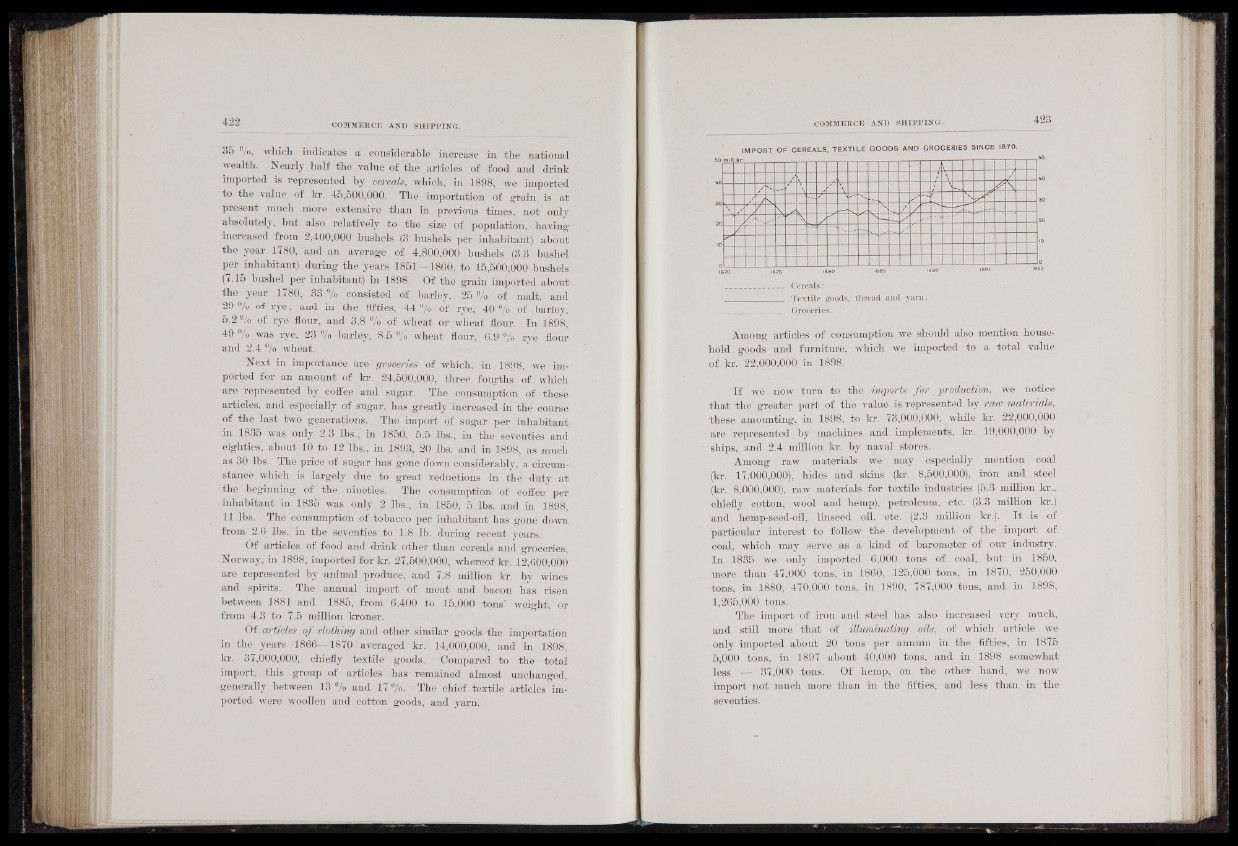
35 %, which indicates a considerable increase in the national
wealth. Nearly half the value of the articles of food and drink
imported is represented by cereals, which, in 1898, we imported
to the value of kr. 45,500,000. The importation of grain is at
present much more extensive than in previous times, - not only
absolutely, but also relatively to the size of population,' having
increased from 2,400,000 bushels (3 bushels per inhabitant) about
the year 1780, and an average of 4,800,000 bushels (3.3 bushel
per inhabitant) during the years 1851—1860, to 15,500,000 bushels
(7.15 bushel per inhabitant) in 1898. Of the grain imported about
the year 1780, 33 % consisted of barley, 25 % of malt, and
29% of rye; and in the fifties, 44 % - of rye, 4 0% of .barley,
5.2 % of rye flour, and 3.8 % of wheat or wheat flour. In 1898,
49 % was rye, 23 % barley, 8.5 % wheat flour, 6.9 % rye flour
and 2.4 % wheat.
Next in importance are groceries of which, in 1898, we imported
for an amount of kr. 24,500,000, three fourths of which
are represented by coffee and sugar. The consumption of these
articles, and especially of sugar, has greatly'increased in the course
of the last two generations. The import of sugar per inhabitant
in 1835 was only 2.3 lbs., in 1850, 5.5 lbs., in the seventies and
eighties, about 10 to 12 lbs., in 1893, 20 lbs. and in 1898, as much
as 30 lbs. The price of sugar has gone down considerably, a circumstance
which is largely due to great reductions in the duty at
the beginning of the nineties. The consumption of coffee per
inhabitant in 1835 was only 2 lbs., in 1850, 5 lbs. and in 1898,
11 lbs.. The consumption of tobacco per inhabitant has gone down
from 2.6 lbs. in the seventies to 1.8 lb. during recent years.
Of articles of food and drink other than cereals and groceries,
Norway, in 1898, imported for kr. 27,500,000, whereof kr. 12,600,000
are represented by animal produce, and 7.8 million kr. by wines
and spirits. The annual import of meat and bacon has risen
between 1881 and 1885, from 6,400 to 15,000 tons’ weight, or
from 4.3 to 7.5 million kroner.
Of articles of clothing and other similar goods the importation
in the years 1866—1870 averaged kr. 14,000,000, and in 1898,
kr. 37,000,000, chiefly textile goods. Compared to the total
import, this group of articles has remained almost unchanged,
generally between 13 % and 17 %. The chief textile articles imported
were woollen and cotton goods, and yam.
IMPORT OF CEREALS, T E X T ILE GOODS AND GROCERIES SINCE 1870.
1 / \
/ H/ 1 ! \ / 1 ggj
a — \
\ 8 V / / 77 i
&
__ Cereals;
_. Textile goods; thread and yarn;
.... Groceries.
Among articles of consumption we should also mention household
goods and furniture, which we imported to a total value
of kr, 22,000,000 in 1898.
If we now turn to the imports for production, we notice
that the greater part of the value is represented, by raw materials,
these amounting, in 1898, to kr. 73,000,000, while kr. 22,000,000
are represented by machines and implements, kr. 19,000,000 by
ships, and 2.4 million kr. by naval stores.
Among raw materials we may especially mention coal
(kr. 17,000,000), hides and skins (kr. 8,500,000), iron and steel
(kr. 8,000,000), raw materials for textile industries (5.3 million kr.,
chiefly cotton, wool and hemp), petroleum, etc. (3.3 million kr.)
and hemp-seed-oil, linseed -oil, etc. (2.3 million kr.). I t is of
particular interest to follow the development of the import of
coal, which may serve as a kind of barometer of our industry.
In 1835 we only' imported 6,000 tons of coal, but in 1850,
more than 47,000 tons, in 1860, 125,000 tons, in 1870, 250,000
tons, in 1880, 470,000 tons, in 1890, 787,000 tons, and in 1898,
1.265.000 tons.
The import of iron and steel has also increased very much,
and still more that of illuminating oils, of which article we
only imported about 20 tons per annum in the fifties, in 1875
5.000 tons, in 1897 about 40,000 tons, and in 1898 somewhat
leas — 37,000 tons. Of hemp, on the other hand, we now
import not much more than in the fifties, and less than in the
seventies.